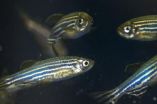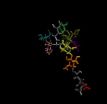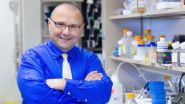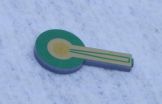(Press-News.org) Unlike salamanders, mammals can't regenerate lost limbs, but they can repair large sections of their ribs.
In a new study in the Journal of Bone and Mineral Research, a team directed by USC Stem Cell researcher Francesca Mariani takes a closer look at rib regeneration in both humans and mice.
The first author of the paper, USC medical student Marissa K. Srour, was a USC undergraduate when she started the project, which earned a 2011 USC Discovery Scholar Prize. Each year, 10 graduating seniors win these coveted prizes, which recognize exceptional new scholarship.
Using CT imaging, Srour, Mariani and their colleague Janice Lee from the University of California, San Francisco, monitored the healing of a human rib that had been partially removed by a surgeon. The eight centimeters of missing bone and one centimeter of missing cartilage did partially repair after six months.
To better understand this repair process, they surgically removed sections of rib cartilage — ranging from three to five millimeters — from a related mammal, mice. When they removed both rib cartilage and its surrounding sheath of tissue — called the "perichondrium," the missing sections failed to repair even after nine months. However, when they removed rib cartilage but left its perichondrium, the missing sections entirely repaired within one to two months.
They also found that a perichondrium retains the ability to produce cartilage even when disconnected from the rib and displaced into nearby muscle tissue — further suggesting that the perichondrium contains progenitor or stem cells.
"We believe that the development of this model in the mouse is important for making progress in the field of skeletal repair, where an acute clinical need is present for ameliorating skeletal injury, chronic osteoarthritis and the severe problems associated with reconstructive surgery," said Mariani, assistant professor of Cell and Neurobiology and principal investigator in the Eli and Edythe Broad Center for Regenerative Medicine and Stem Cell Research at USC. "At the early stages in our understanding, the mouse provides us with an exceptional ability to make progress, and we are excited about the potential for using cells derived from the rib perichondrium or using rib perichondrium-like cells for regenerative therapy."
INFORMATION:
Additional co-authors include: Jennifer L. Fogel, Kent T. Yamaguchi, Aaron P. Montgomery, Audrey K. Izuhara, Aaron L. Misakian, Stephanie Lam and Daniel L. Lakeland from USC; and Mark M. Urata from Children's Hospital Los Angeles.
Funding came from an Oral and Maxillofacial Surgery Foundation Research Award; the Baxter Medical Scholar Research Fellowship; USC undergraduate fellowships; the Provost, Dean Joan M. Schaeffer, and Rose Hills fellowships; a California Institute of Regenerative Medicine (CIRM) training fellowship; CIRM BRIDGES fellowships through California State University, Fullerton, and Pasadena City College; and the James H. Zumberge Research and Innovation Fund.
The lab also received support for this study and future work from a new National Institutes of Health (NIH) Exploratory/Developmental Research Grant Award (R21AR064462) — given to high-risk, high-reward studies that break new ground or embark in novel directions. The lab earned this prestigious $450,000 grant from the NIH's National Institute of Arthritis and Musculoskeletal and Skin Diseases (NIAMS).
The Mariani Lab will also continue its pioneering research through a second new grant from the Merck Investigator Studies Program as well as through a USC Regenerative Medicine Initiative Award with colleagues Gage Crump and Jay Lieberman.
As Mariani explained, "These grants will allow us to address several key questions: Which cells are involved in mediating the repair? How big of a piece of rib can we take out and still see repair? And can we use cells from the rib to get repair in another part of the skeleton? By answering these questions, we are accelerating the discovery of new regenerative therapies for the patients who need them the most."
USC researchers discover the healing power of 'rib-tickling'
2014-09-15
ELSE PRESS RELEASES FROM THIS DATE:
Zebrafish model of a learning and memory disorder shows better treatment
2014-09-15
PHILADELPHIA — Using a zebrafish model of a human genetic disease called neurofibromatosis (NF1), a team from the Perelman School of Medicine at the University of Pennsylvania has found that the learning and memory components of the disorder are distinct features that will likely need different treatment approaches. They published their results this month in Cell Reports.
NF1 is one of the most common inherited neurological disorders, affecting about one in 3,000 people. It is characterized by tumors, attention deficits, and learning problems. Most people with NF1 have ...
Advancing the science for health programming in crisis conditions
2014-09-15
September 12, 2014 -- Humanitarian crises are becoming increasingly complex and a growing threat to the health and safety of populations. An improved evidence-base to guide interventions in the countries most vulnerable to these conditions is more critical than ever. A paper by researchers at Columbia University's Mailman School of Public Health published online in the journal Science, looks at the challenges of doing research in such settings and the strategies that must be adopted for scientific advance.
"The circumstances of humanitarian crises present many barriers ...
Decoding 'sweet codes' that determine protein fates
2014-09-15
VIDEO:
Here are movies of dynamic behavior of a sugar chain on the basis of NMR-validated simulations. This chain has a particular sugar (green circle).
Click here for more information.
We often experience difficulties in identifying the accurate shape of dynamic and fluctuating objects. This is especially the case in the nanoscale world of biomolecules. The research group lead by Professor Koichi Kato of the Institute for Molecular Science, National Institutes of Natural Sciences ...
You don't walk alone
2014-09-15
65 million people around the world today suffer from epilepsy, a condition of the brain that may trigger an uncontrollable seizure at any time, often for no known reason. A seizure is a disruption of the electrical communication between neurons, and someone is said to have epilepsy if they experience two or more unprovoked seizures separated by at least 24 hours.
Epilepsy is the most common chronic disease in pediatric neurology, with about 0.5% of children developing epilepsy during their lifetime. A further 30% of epileptic children develop refractory ...
Walking or cycling to work improves wellbeing, University of East Anglia researchers find
2014-09-15
Walking or cycling to work is better for people's mental health than driving to work, according to new research by health economists at the University of East Anglia and the Centre for Diet and Activity Research (CEDAR).
A report published today reveals that people who stopped driving and started walking or cycling to work benefited from improved wellbeing. In particular, active commuters felt better able to concentrate and were less under strain than if they travelled by car.
These benefits come on top of the physical health benefits of walking and cycling that are ...
Nature: New drug blocks gene driving cancer growth
2014-09-15
When active, the protein called Ral can drive tumor growth and metastasis in several human cancers including pancreatic, prostate, lung, colon and bladder. Unfortunately, drugs that block its activity are not available. A study published today in the journal Nature uses a novel approach to target the activation of these Ral proteins: "When you want to keep an alligator from biting you, you can tie its mouth shut. We took another approach – we put a stick in its mouth to hold it open," says Dan Theodorescu, MD, PhD, professor of Urology and Pharmacology, director of the ...
Blood-cleansing biospleen device developed for sepsis therapy
2014-09-15
Things can go downhill fast when a patient has sepsis, a life-threatening condition in which bacteria or fungi multiply in a patient's blood -- often too fast for antibiotics to help. A new device inspired by the human spleen and developed by a team at Harvard's Wyss Institute for Biologically Inspired Engineering may radically transform the way doctors treat sepsis.
"Even with the best current treatments, sepsis patients are dying in intensive care units at least 30 percent of the time," said Mike Super, Ph.D., Senior Staff Scientist at the Wyss Institute. "We need ...
Muscular dystrophy: Repair the muscles, not the genetic defect
2014-09-15
ANN ARBOR, Mich.---A potential way to treat muscular dystrophy directly targets muscle repair instead of the underlying genetic defect that usually leads to the disease.
Muscular dystrophies are a group of muscle diseases characterized by skeletal muscle wasting and weakness. Mutations in certain proteins, most commonly the protein dystrophin, cause muscular dystrophy in humans and also in mice.
A University of Michigan team led by cell biologist Haoxing Xu, discovered that mice missing a critical calcium channel inside the cell, called TRPML1, showed similar muscle ...
Three's a charm: NIST detectors reveal entangled photon triplets
2014-09-15
BOULDER, Colo – Researchers at the University of Waterloo in Canada have directly entangled three photons in the most technologically useful state for the first time, thanks in part to superfast, super-efficient single-photon detectors developed by the National Institute of Standards and Technology (NIST).
Entanglement is a special feature of the quantum world in which certain properties of individual particles become linked such that knowledge of the quantum state of any one particle dictates that of the others. Entanglement plays a critical role in quantum information ...
The Lancet: Some lung cancer patients could live longer when treated
2014-09-15
Treating advanced small-cell lung cancer (SCLC) with thoracic (or chest) radiation therapy in addition to standard treatment significantly prolongs long-term survival and reduces cancer recurrence in the chest by almost 50%, according to new research published in The Lancet and being presented simultaneously at ASTRO's 2014 Annual Meeting in San Francisco.
The authors say that as the thoracic radiotherapy is well tolerated, it should to be routinely offered to all SCLC patients with extensive disease whose cancer responds to chemotherapy.
SCLC is an aggressive cancer ...





